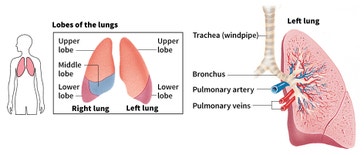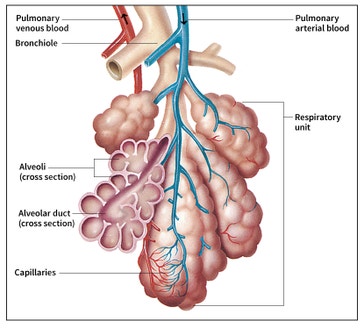오늘의 한마디
Lung
Lung is the breathing organ of mammals, birds, and reptiles. Most adult amphibians also have lungs. The main job of the lungs is to exchange gases. As blood flows through the lungs, it picks up oxygen from the air and releases carbon dioxide. The body needs oxygen to obtain energy from food, and it produces carbon dioxide as a waste product. This article discusses the human lungs, but the lungs of other animals function in a similar way.
Parts of the lungs.
Human beings have two lungs—a left lung and a right lung—which fill up most of the chest cavity. A lung has a spongy texture and may be thought of as an elastic bag filled with millions of tiny air chambers called alveoli. If the walls of the alveoli could be spread out flat, they would cover about half a tennis court. The somewhat bullet-shaped lungs are suspended within the ribcage. They extend from just above the first rib down to the diaphragm, a muscular sheet that separates the chest cavity from the abdomen. A thin, tough membrane called the visceral pleura covers the outer surface of the lungs. The heart, large blood vessels, and esophagus (the tube connecting the mouth and stomach) lie between the two lungs.
The lungs are designed to receive air, which enters the body through the mouth or nose. The air passes through the pharynx (back of the nose and mouth) and the larynx (voice box) and enters the bronchial tree—a system of tubes that leads to the alveoli. The largest of these tubes is the trachea (windpipe), which divides into two smaller tubes called bronchi. Each bronchus leads to one lung. Within the lung, the bronchus divides further into smaller and smaller tubes, much as a tree limb divides into branches and twigs. The final "twigs" are tiny tubes called bronchioles. The smallest bronchioles, called terminal bronchioles, lead to the respiratory units of the lung. The respiratory units are made up of many alveolar ducts. Each duct supplies about 20 alveoli. The very thin walls of each alveolus contain networks of extremely small blood vessels called pulmonary capillaries. Gas is exchanged between the blood in these capillaries and the gas in the alveoli.
Three to five terminal bronchioles and the alveoli that they supply with air form a lobule. Many lobules unite to form the major subdivisions of the lung, called lobes. The left lung has two lobes, and the right lung has three. Each lobe has its own branches of bronchi and blood vessels, so a diseased lobe may be removed without sacrificing the usefulness of the other lobes.
Blood reaches the lung through two routes. Almost all of the blood comes through the pulmonary circulation. This blood has already circulated through the body tissues, where it has given up oxygen and picked up carbon dioxide. A small amount of blood reaches the lungs through the bronchial circulation. This blood is rich in the oxygen and nutrients that the airway tissues—like all other body tissues—need.
Gas exchange in the lungs.
To supply oxygen to the blood and remove carbon dioxide from it, the lungs need to draw in fresh gas and expel stale gas. Fresh gas is drawn in when the diaphragm and other muscles in the chest wall contract. This action—called inspiration or inhalation—makes the chest volume larger and causes the lungs to expand. The expansion lowers the pressure in the lungs, and air from the atmosphere flows in. When the muscles relax, the lungs return to a smaller volume, and gas flows out into the atmosphere. This action is called expiration or exhalation.
Blood entering the lungs through the pulmonary circulation is dark-colored, low in oxygen, and high in carbon dioxide. It is pumped by the right side of the heart into the pulmonary arteries, which lead to the lungs. The pulmonary arteries divide into smaller and smaller blood vessels, ending with pulmonary capillaries in the walls of the alveoli. The alveolar walls are so thin that oxygen and carbon dioxide move through them easily. Oxygen passes from the alveoli to the blood in the capillaries. At the same time, carbon dioxide leaves the blood and enters the alveoli. As this exchange takes place, the blood becomes bright red. It then enters the pulmonary venous system. In this system, small vessels join to form larger vessels. The largest vessels, the pulmonary veins, carry blood to the left side of the heart. The oxygen-rich blood is then pumped by the left side of the heart back to the body tissues.
Other jobs of the lungs.
Because the lungs must inhale the air from the environment, they are exposed to bacteria, viruses, dust, and pollutants that are mixed with the air. A sticky fluid called mucus lines the airways and traps most of these foreign substances. Tiny, hairlike structures called cilia move together in a wavelike manner that pushes the mucus upward into the throat. There, the mucus and its trapped "invaders" are coughed up or harmlessly swallowed. Some substances do not get caught in the mucus and thus enter the alveoli. There, special cells called alveolar macrophages engulf the particles and, in most cases, destroy them.
The lungs also help clean the blood of certain harmful substances. Blood flowing through the capillaries of the lung is filtered so that particles such as blood clots and fat globules are removed. Special cells and enzymes then break up and remove the trapped material.
Another function of the lungs can be compared to the operations of a chemical processing plant. Some cells make a fatty substance called surfactant, which coats the alveoli and allows them to expand easily. Other cells add, remove, or change chemical substances in the blood that affect the function of the lungs or other organs. Finally, the gas exhaled by the lungs is used to make the vocal cords in the larynx vibrate. This action creates the sound necessary for speech.
Diseases of the lungs
Diseases of the lungs occur despite the defenses provided by the mucus and macrophages. Sometimes, the number of harmful particles reaching the alveoli is so great that the macrophages cannot remove them all. In other cases, the particles can resist or destroy the macrophages and remain in the lung tissue.
Because lung diseases can result from many different causes, they are usually grouped by how they affect lung functions. Obstructive lung diseases, such as emphysema, asthma, and chronic bronchitis, cause the airways to become partly blocked or narrower, making it more difficult for air to move through them. Cigarette smoking and air pollution are major causes of these diseases. Restrictive lung diseases make it harder for the respiratory system to expand. They can cause a stiffening of the lung or chest wall or make the respiratory muscles unable to respond to nerve signals from the brain. Breathing substances such as asbestos, silica, and coal dust can cause some types of restrictive disease. Pulmonary vascular diseases affect the circulation of blood in the lungs. For example, in pulmonary hypertension, the small blood vessels of the lung become narrower, making it difficult for the right side of the heart to pump blood.
Some diseases are difficult to categorize because they can harm the lungs in a number of ways. Some pollutants—particularly cigarette smoke—affect the cilia, causing the upward movement of mucus to slow or stop. Smoking cigarettes is also a major cause of lung cancer. Infectious lung diseases, such as tuberculosis and pneumonia, are caused by bacteria, viruses, or other organisms. These diseases are serious health concerns in all parts of the world.
Modell, Harold I., and Jack Hildebrandt. "Lung." World Book Student , World Book, 2020,www.worldbookonline.com/student-new/#/article/home/334180. Accessed 17 Feb. 2020.

